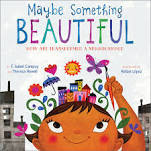The Singing Bones
by Shaun Tan
185 pages
The Singing Bones is an amazing work of art. Those of you who know me well know that I love Shakespeare, CS Lewis, JRR Tolkien, art, fairy tales, and mythology, each of those topics being bound to the others with silken threads of delight. Well, this book furnishes delight for the eyes and the mind!
Shaun Tan weaves sculpture, photography, and the fairy tales of the Brothers Grimm into an amazing tapestry of color, horror, enchantment, darkness, and whimsy. He whittles 75 of the Grimm fairy tales down to their verbal core, and using simple materials, sculpts the heart of the tale before photographing the sculpted tableau.
I saw the book and fell in love...book lust...whatever you want to call it, but I had to own this book! No waiting for my turn to borrow, read, and evaluate the book...I ordered it on Amazon the night I saw it!
What makes this book so fascinating? In his foreword to The Singing Bones, Neil Gaiman says that Tan's sculptures "do not look like moments of the stories; instead, they feel like the stories themselves." He goes on to say, "Shaun Tan makes me want to hold these tales close,...inspect them from unusual angles,....makes me wonder...how badly I could hurt someone if I hit them with a story." Not that any of us would actually want to hit someone, but what a mental jolt some of these stories and sculptures produce! Tan himself indicates that he is seeking to portray the concept of the story rather "than a detailed likeness," and his sculptures seem to be "odd objects resting in the dark galleries of our collective subconscious." Think about what true fairy tales are...or were before they became sanitized for modern consumption. They speak to our inner light or darkness, making us take a long look at ourselves to examine who we truly are...hero, villain, or the reluctant bystander who must choose a path.
My particular favorites from the book are:
"The Mouse, the Bird, and the Sausage" because it speaks to work ethic, and I love the intricacies of the scupture;
"The Singing Bone" because of the stark, realistic image portrayed;
"The Wolf and the Seven Young Kids" because I love the images, and it's always great for the good guys to win;
and my most favorite, "The Elves," because this was one of my favorite stories growing up, and the sculpture is so happy and whimsical.
For more information about Shaun Tan and his projects, check out his fascinating site. http://www.shauntan.net/
This is a link to a flyer I recently made promoting Shaun Tan's books. https://www.smore.com/wr963
Oh! I am also in love with his charming little red fox! Where can I get one??!!
EQ: Why have modern versions of fairy tales been sanitized? Did the older, more harsh versions harm us? They have been sanitizing more of the darkness from these stories since the late 60s. Has this improved society?



